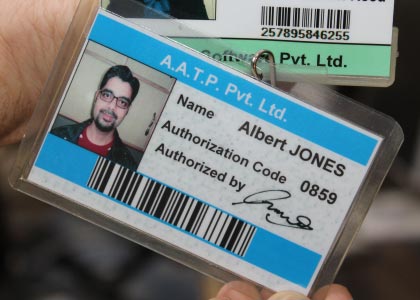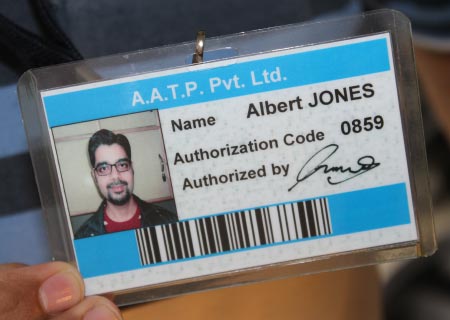The specific details and features of a visitor ID card can vary depending on the organization's requirements and security protocols, but typically include the following elements:
-
Expiry Date:
The ID card is typically valid only for a specific period, which is indicated by an expiry date. Once the visitor's authorized time on the premises is over, the ID card becomes invalid, and the visitor may be required to return it or leave the premises.
-
Visitor Information:
The ID card contains essential information about the visitor, such as their name, photograph, and any other relevant identification details. This information helps in verifying the visitor's identity and ensuring they are authorized to be on the premises.
-
Purpose of Visit:
The ID card may include details about the purpose of the visitor's visit, such as attending a meeting, conducting business, attending an event, etc. This information helps the host organization monitor the activities of the visitor and ensure they are in the appropriate areas.
-
Security Features:
To prevent forgery and unauthorized duplication, visitor ID cards often incorporate various security features. These may include holograms, barcodes, QR codes, embedded microchips, watermarks, or other unique identifiers that can be easily verified by security personnel.
-
Date and Time:
The ID card usually includes the date and time of the visitor's entry into the premises. This information helps in tracking the duration of their visit and identifying any unauthorized individuals who may have overstayed their welcome.
-
Access Permissions:
Depending on the organization's security protocols, the ID card may grant specific access permissions to certain areas or restrict access to sensitive or restricted areas. This helps in maintaining the security and integrity of the premises.
-
Visitor Badge:
In addition to the ID card, visitors may be required to wear a visible badge or lanyard displaying their visitor status. This makes it easy for staff members and security personnel to quickly identify and distinguish visitors from regular employees or authorized personnel.
Importance of Visitor ID Cards:
Visitor ID cards are important for various reasons, particularly in places where security and access control are crucial, such as offices, schools, government buildings, and other institutions. These ID cards serve as a means to identify and track individuals who are not regular employees or members of the organization. Here are several reasons why visitors need ID cards:
-
Security:
ID cards help ensure the security of the premises and the people within. By issuing ID cards to visitors, organizations can easily distinguish between authorized individuals and potential intruders. This helps to prevent unauthorized access, theft, or any other security breaches. ID cards also make it easier for security personnel to quickly identify and validate visitors, enhancing overall safety measures.
-
Access control:
Many organizations have restricted areas that require certain levels of clearance. Visitor ID cards can be programmed with access control features, such as barcodes, magnetic strips, or RFID technology, allowing temporary visitors to access approved areas within the premises. This helps maintain control over sensitive or confidential areas and ensures that visitors are only granted access to designated spaces.
-
Emergency situations:
In case of emergencies like fire outbreaks, natural disasters, medical incidents, and others. Visitor ID cards play an important role in accounting for all individuals present on the organization or business premises. By having visitors wear or carry their identification cards, emergency responders can quickly identify and evacuate everyone, ensuring their personal safety.
-
Identification and tracking:
Visitor ID cards provide a means of identification for individuals who are not familiar to the staff or regular members of the organization. These cards typically contain important information such as the visitor's name, photograph, date of visit, and purpose of the visit. This helps staff members easily identify visitors and enables them to track the movement and whereabouts of visitors within the premises.
-
Liability and legal requirements:
Organizations have a responsibility to ensure the safety of their visitors. By requiring visitors to wear or carry ID cards, organizations can establish a record of visitors and their activities on the premises. In case of any incidents or legal issues, this information can be crucial for investigation purposes and liability determination.
-
Visitor management:
Visitor ID cards are often integrated into visitor management systems, which streamline the check-in and check-out processes. These systems can capture visitor data, generate visitor badges or temporary access cards, and provide an efficient way to manage visitor traffic and ensure a smooth experience for both visitors and staff members.
Overall, visitor ID cards serve as a practical and effective tool for enhancing security, controlling access, tracking visitors, and maintaining a safe environment within organizations. They provide a means of identification, help differentiate authorized individuals from potential threats, and contribute to efficient visitor management systems.
Types of Information Included on a Visitor ID Card
A visitor ID card typically contains specific information to identify the individual and provide relevant details about their visit. The exact information included on a visitor ID card may vary depending on the organization's requirements and the level of security needed. Here are the common elements found on a visitor ID card:

-
Visitor's Name: The visitor's full name is usually the primary piece of information displayed on the ID card. This helps in identifying the visitor and addressing them properly during their visit.
-
Visitor's Photograph: A photograph of the visitor is an essential component of the ID card. It serves as a visual reference to ensure the identity of the visitor matches the information on the card. The photograph also aids in recognizing the visitor during their stay.
-
Visitor's Identification Number: A unique identification number or code is often assigned to each visitor. This number allows for easy tracking and referencing of visitor records in the organization's database or visitor management system.
-
Date of Visit: The date of the visitor's arrival is typically included on the ID card. This information helps in monitoring the visitor's duration of stay and provides a reference for future visits or any necessary follow-ups.
-
Purpose of Visit: The purpose of the visitor's visit is often indicated on the ID card. It could be a meeting, interview, delivery, appointment, or any other specific reason for the visit. This information helps the staff members or security personnel in directing the visitor to the appropriate area or contact person.
-
Host Information: The name or department of the person responsible for hosting or receiving the visitor is commonly listed on the ID card. This facilitates communication and ensures that the visitor can easily locate their designated contact within the organization.
-
Expiration Date/Time: For short-term visits, an expiration date or time may be included on the ID card. This indicates the duration of validity for the visitor's access privileges and helps enforce time-limited access to the premises.
-
Organization Logo: The logo or branding of the organization issuing the ID card is often displayed on the card. This helps in quickly identifying the organization to which the visitor is associated during their visit.
-
Security Features: Depending on the level of security required, visitor ID cards may incorporate various security features such as barcodes, magnetic strips, RFID chips, or holograms. These features help authenticate the card's legitimacy and enable access control systems to scan and verify the card.
-
Disclaimers or Instructions: Additional information, disclaimers, or specific instructions related to the visitor's responsibilities or regulations may be included on the ID card. This ensures that visitors are aware of any necessary guidelines or protocols they need to follow while on the premises.
Conclusion: The specific details and design of a visitor ID card can vary depending on the organization's policies, security requirements, and the capabilities of their visitor management system. By including the aforementioned information on the ID card, organizations can ensure efficient visitor identification, tracking, and access control.
Ensuring for Visitor Privacy when using Visitor ID Cards
To ensure visitor privacy when using visitor ID cards, consider the following detailed steps:
-
Limited Access:
Restrict access to visitor data to authorized personnel only. Implement role-based access controls and provide training to staff on handling sensitive information. Regularly review and update access permissions based on employee responsibilities.
-
Purpose and Necessity:
Clearly define the purpose of collecting visitor information and ensure it is necessary. Collect only the minimum required data for security and identification purposes. Avoid requesting sensitive or excessive information.
-
Informed Consent:
Inform visitors about the purpose of collecting their data and obtain their consent. Clearly communicate how the data will be used, stored, and protected. Allow visitors to provide alternative means of identification if they have concerns.
-
Secure Data Storage:
Implement robust security measures to protect visitor data. Store it in encrypted formats, both in transit and at rest. Use secure servers or cloud storage services with strong access controls, firewalls, and intrusion detection systems.
-
Data Retention and Disposal:
Establish a clear data retention policy and adhere to it. Determine how long visitor data will be stored and securely dispose of it when no longer needed. Ensure proper shredding or deletion of physical and digital records.
-
Physical Security:
Protect physical ID cards from unauthorized access. Implement secure storage and access controls for visitor records, ensuring they are locked away when not in use. Limit the distribution and circulation of physical ID cards.
-
Anonymization or Pseudonymization:
Where applicable, consider anonymizing or pseudonymizing visitor data. Replace personally identifiable information (PII) with non-identifying or pseudonymous data to reduce privacy risks. For example, use a unique ID instead of displaying the visitor's full name.
-
Transparent Policies:
Clearly communicate your privacy policies to visitors. Display notices or signs explaining the purpose of ID cards, how data will be handled, and the measures in place to protect visitor privacy. Make privacy policies easily accessible on your website or at the reception area.
-
Regular Auditing:
Conduct periodic audits of your visitor ID card system and privacy practices. Review access logs, monitor system activity, and check compliance with privacy regulations. Address any vulnerabilities or gaps identified during the audit.
-
Continuous Education:
Train your staff on visitor privacy best practices. Provide guidance on handling personal information, maintaining confidentiality, and responding to visitor inquiries. Keep employees informed about changes in privacy regulations and ensure they stay updated on privacy practices.
By implementing these measures, you can enhance visitor privacy when using ID cards, fostering trust and demonstrating your commitment to protecting their personal information.
Posted By: 👤 Techsavvy
Updated On: 📅
